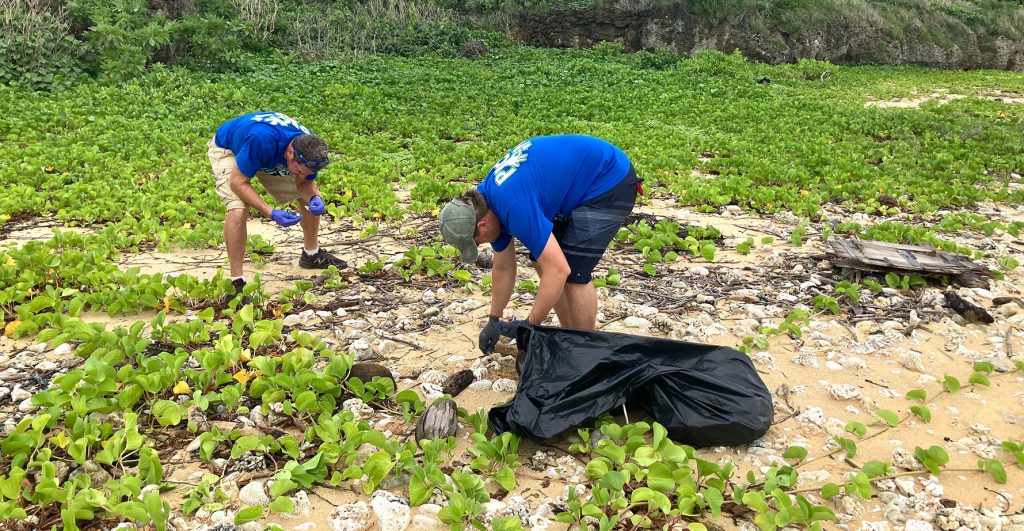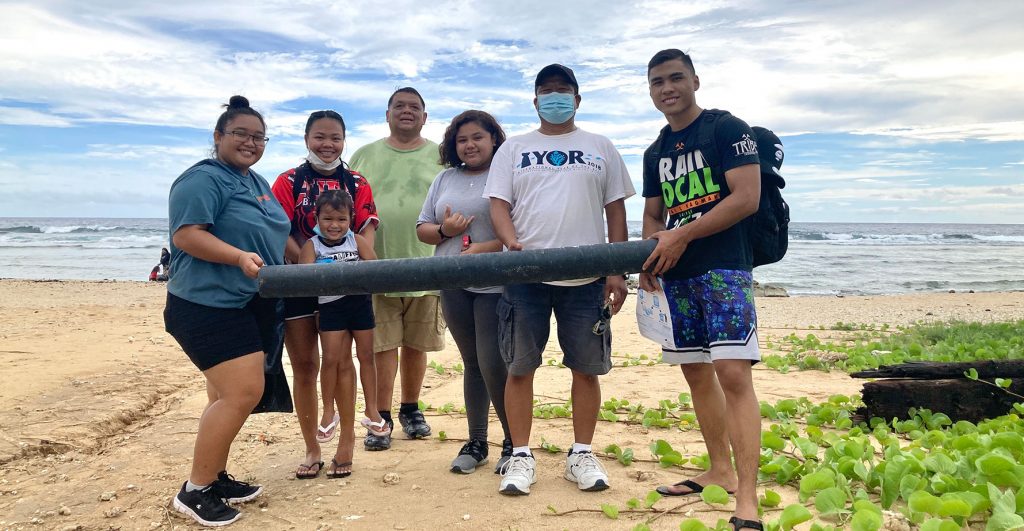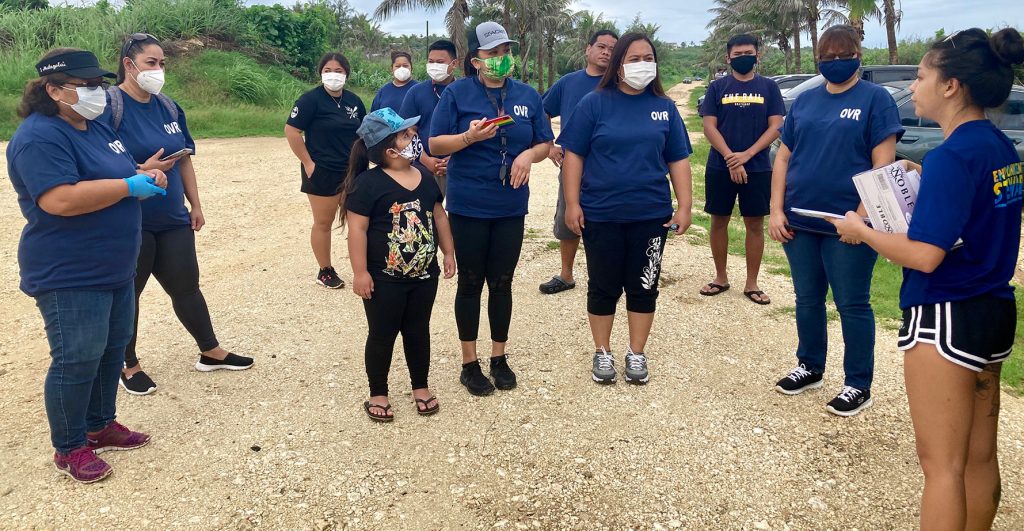In cleaning up the island, every small action counts

⦁ BECQ-Division of Environmental Quailty’s Travis Spaeth and Larry Maurin sift through sand to pick up microplastics (plastics less than 2.5 cm) at Tank Beach in Kagman for the International Coastal Cleanup celebration. (IVA MAURIN)
Hundreds in the community walked the shores early morning Saturday, shifted through sand, plucked microplastics, picked up trash, all to take part in the celebration of the International Coastal Cleanup, to join the global fight for “Trash-Free Seas.”
As a background, worldwide, it is estimated that each person generates an average of over half a kilo of waste per day, with about 2 billion metric tons of municipal solid waste produced yearly, and with a third of it not managed properly. What’s worse? The World Bank projected that if nothing is done, global waste generation could increase to up to 70% by 2050.
Are we really heading that direction? If you look at it, based on the ICC in Saipan alone, last year volunteers cleaned up 47 locations and collected over 5,000 lbs of trash. This year, over 7,000 lbs of trash had been collected in just 40 locations.
What is happening? Wanton disregard for the environment. People going to the beaches and leaving trash behind, waiting for the next person to pick it up… or those cleaning up their yards but leaving their collected trash by the beach road, suffering from the NIMBY syndrome—as long as it is “not in my backyard,” then “I am okay with trash.”
Out of sight, out of mind.
Take trash to the right place
Joining the appeal for people to properly manage trash is Bureau of Environmental and Coastal Quality administrator Eli Cabrera. Joined by his family, he also spent his Saturday morning picking up trash at Tank Beach in Kagman.
“Throughout the island, I can imagine how many trash bags that will be picked up, some of them maybe residential trash that were put in on the beach side. All I’m asking the public is [that] the dump is open Monday, Tuesday, Thursday, Friday, Saturday. Bring [your trash] to the landfill or the transfer station.”
Both the Marpi Landfill and the Lower Base Transfer Station are open all week except Wednesday.
“Do not leave [trash] by the beach area because there’s a lot of dogs, scavengers [that get into] the trash bag. Then [people] call up and [report] that there’s a lot of littering. Well, littering should have stopped if they bring [their trash] to the right place.”

⦁ Bureau of Environmental and Coastal Quality administrator Eli Cabrera, with his family, after a full Saturday morning spent picking up trash at Tank Beach in Kagman for the International Coastal Cleanup celebration. (IVA MAURIN)
The BECQ administrator also stressed the importance of maintaining and keeping the shores clean, and also extended appreciation to all the cleanup volunteers.
“It’s part of the environment. It’s part of our environment… People are coming to use the area so we want to make sure it’s always clean. [You] have to do your part, clean before you go.”
Small actions matter
While more and more beach cleanups are being conducted on island, what makes the International Coastal Cleanup different is that on this global event, data on trash is collected. Here in the CNMI, BECQ’s Division of Coastal Resources Management oversees this cleanup and data collection, and submits them to ICC main organizer, Ocean Conservancy.
The data that is collected, even if it is just one day out of a year, helps not just environmental organizations, researches, or scientists, but governments all over the world as well, to come up with projects and programs that could solve the problem.
For the CNMI, and for the past few years, top trash has always been cigarette butts, plastic spoons, cutleries, cans, and take-out boxes.
In response to this, according to DCRM director Janice Castro, some of the projects that they do include helping raise awareness about single-use plastics, the dangers they pose to the marine environment.
“Just be more conscious about making eco-friendly choices, more sustainable choices [such as] using reusable bags, reusable food container, skipping the straw. Even small actions really contribute to the larger picture.”
The advocacy does not stop after the international coastal cleanup event too. There are year-round projects and programs in the community to help keep the islands clean and pristine.
Year-round advocacy
While we are still waiting on the 2020 ICC data, five of the top 10 trash collected in the CNMI at the last International Coastal Cleanup were plastic. Microplastics (plastic pieces that are smaller than 2.5 cm) ranked second, plastic bottle caps and lids were fourth and fifth, respectively, and plastic bottles and food wrappers ranked seventh and eighth.
DCRM launched the Plastic-Free Marianas program last year, working with businesses and guiding them into adopting plastic-free packaging right into their stores. There is also a bill pending at the Legislature banning the use of single-use plastic bags.
Castro also said that DCRM is also getting ready for the return of the Watershed Warriors program, geared towards elementary school students, teaching them about the different watersheds on Saipan, but more particularly, the watershed they live in, and what they can do to help improve the health of their watersheds.

⦁ CNMI Office of Vocational Rehabilitation staff is briefed by BECQ-Division of Coastal Resources Management’s Mallory Muna on the data collection aspect of the cleanup held last Saturday at Tank Beach in Kagman for the International Coastal Cleanup celebration. (IVA MAURIN)
“The watershed is an area from which the water drains from the ridge to the reef, so every action that happens on land in that watershed gets carried down to the water,” Castro explained.
“When there are red flag events at the beaches, that’s because the water somewhere washed something on the land down to the water, and brought that bacteria, that contamination down there. It’s teaching students how to implement best practices and teach their families [and] their friends [not to] litter because what happens on the land happens on the sea too.”
Now, as we wait for this year’s official ICC data for the CNMI, let us all be mindful of the trash we generate. And, as we are being advised, let’s all clean up, pick up, plus if we have time, volunteer.
Lions Club International region 2 chair Al Cabael, one of the island’s many volunteers, said it right, “Being in this beautiful island, it is everyone’s obligation to keep our environment, especially our beaches clean. In doing so, we are also giving a strong message to the younger generation to take good care of our nature.”























